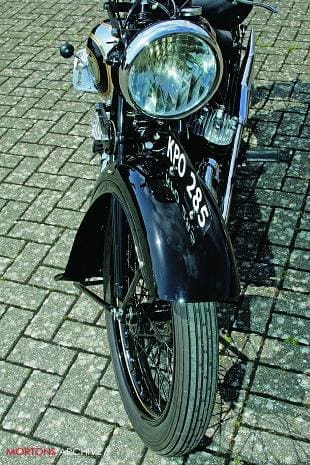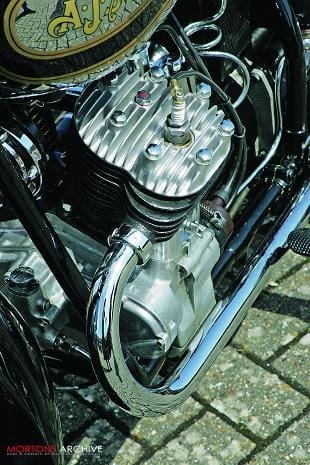
The mention of transverse V-twins automatically brings Moto Guzzis to mind, as the layout has been synonymous with the Italian firm since the 1960s. But AJS made a motorcycle in this format more than a third of a century earlier, and – judging by the latest restoration to emerge from Sammy Miller’s ever-active workshop – they made a pretty good job of it. To be fair, the even earlier Panthette also used the same layout, but it proved too small and problematical to hit the mark with either traditional, or potential, Panther owners.
The AJS S3, on the other hand, could have been right on target. It was clearly innovative in respect of its engine and drive train, but AJS determinedly avoided an outlandish appearance or specification. Wisely, the Wolverhampton firm resisted the temptation to provide the rear suspension that the public hankered after but never purchased. And they shunned the enclosed bodywork that frightened potential buyers away from futuristic machines like the Ascot-Pullin.
Instead, there is a substantial brazed lug frame, with duplex tubes in all the right places, and standard AJS girder forks. If you can disregard the engine, the machine looks and feels utterly conventional, with the sort of mudguards and petrol tank you’d expect on a luxury post-vintage tourer, and the riding position is as trendily low as was expected when the S3 was launched in April 1931.
AJS evidently felt a touch of car-style refinement was desirable in such an up-market machine, and fitted a well-equipped instrument panel onto the tank. OK, the clock and speedometer were optional extras, but I daresay most of those who forked out £65 for the S3 would have found the extra £1-10s and £2 respectively (plus a further five shillings if you wanted a trip odometer) rather than have blanking plates in the panel. There’s also a knob in the centre that controls the ignition, and a separate lighting switch.
 And that’s significant, because electric lights were provided just as they were in cars, and this, remember, was in an era when acetylene lights were much more common on motorcycles, and considerably cheaper. This wasn’t altogether generosity or a whim on the part of AJS, because a critical aspect of the S3 – and another car-like feature – was that it had coil ignition. Consequently it couldn’t function without a dynamo and a battery, so the money saved by omitting the magneto could be spent on a modern lighting system.
And that’s significant, because electric lights were provided just as they were in cars, and this, remember, was in an era when acetylene lights were much more common on motorcycles, and considerably cheaper. This wasn’t altogether generosity or a whim on the part of AJS, because a critical aspect of the S3 – and another car-like feature – was that it had coil ignition. Consequently it couldn’t function without a dynamo and a battery, so the money saved by omitting the magneto could be spent on a modern lighting system.
Few manufacturers would have chosen to go down this route, but AJS had actually tried their hand at making cars, so the advantages and shortcomings of the technology were familiar to them. For instance, they drove the dynamo by a flat rubber belt, rather than the more obvious chain, so that the sales literature could claim that it would be: ‘noiseless, and by its nature cannot damage the dynamo in case of a backfire or violent acceleration’. I’m not sure that mentioning the possibility of a backfire was very good sales psychology, but I suppose that was counterbalanced by the suggestion that the acceleration could be violent enough to cause problems!
Another car-like aspect was the absence of exposed cabling. Routing the clutch and front brake cables through the handlebars was nothing new of course – it had been the obvious method with the inverted levers used on most early machines – but throttle and choke cables were normally left to wave in the wind. With the switch to twistgrips at the end of the vintage era, however, more ambitious makers like AJS took the opportunity to incorporate a scroll mechanism that enabled the cable to neatly run parallel with the bars. Unfortunately, wear and backlash usually set in quite quickly, but the twistgrip on the S3 is about as good as they get.
So far so good, but the routing of the front brake cable is a good idea taken to extremes. It passes from the lever into the handlebars, emerges near the centre, and then dives into the fork leg, to emerge right down by the brake plate. “It was a nightmare to feed in,” grimaces Bob Stanley, Sammy Miller’s ace restorer. “I eventually dragged it though on the end of a welding rod. And the brake’s not even very good because all that free length results in a spongy operation.” The more you look at the set-up, the worse it seems. Only the inner portion of the Bowden cable goes through the fork leg (that’s why it was so difficult to feed through), and for some unfathomable reason AJS chose to put it through the curved member rather than the straight one. As a result friction is maximised whenever it’s put under tension, and the cable could eventually saw a slot in the tube!
Post-vintage standards
Still, the brakes are generously sized by immediate post-vintage standards, so perhaps I shouldn’t grumble too much. And the rest of the cycle parts are almost beyond reproach. The front mudguard is particularly impressive; its elegant and voluminous shape encloses the fork legs and is sealed around them with neat little plates. It’s as well that it’s effective; because immediately behind it sits the oil pump, and that’s not something you really want grit blasted or submerged beneath a layer of road muck. The only slightly odd thing about the machine’s appearance is that the layout of the engine and transmission creates a visual gap in the middle. That’s compounded by the neatness of the engine, so that viewed from the side – when you only see one 250cc pot – you get the impression that AJS absent-mindedly fitted a commuter’s engine into a tourer’s frame.
 Closer study of the engine, though, shows that it exhibits a nice mixture of the avant-garde and common sense. At the time, V-twins were very familiar to the everyday motorcyclist, so there was no need to explain the engine’s basics, and AJS’s publicity material was free to wax lyrical about the virtues of its orientation, saying: ‘The engine is set across the frame, and as the cylinders project on either side, they are in an unobstructed and equal air stream, consequently both are equally and perfectly cooled. No multi-cylinder engine, with cylinders in line can claim that all cylinders run at the same temperature. This matter of even temperature plays an important part in securing slow running and a smooth flow of power at all speeds.’
Closer study of the engine, though, shows that it exhibits a nice mixture of the avant-garde and common sense. At the time, V-twins were very familiar to the everyday motorcyclist, so there was no need to explain the engine’s basics, and AJS’s publicity material was free to wax lyrical about the virtues of its orientation, saying: ‘The engine is set across the frame, and as the cylinders project on either side, they are in an unobstructed and equal air stream, consequently both are equally and perfectly cooled. No multi-cylinder engine, with cylinders in line can claim that all cylinders run at the same temperature. This matter of even temperature plays an important part in securing slow running and a smooth flow of power at all speeds.’
That probably over-simplifies the situation, because the rotation of the crank means that one cylinder of a V-twin always gets the majority of cooling oil thrown at it – that’s the reason that the rear cylinder of conventional V-twins doesn’t overheat – but the S3’s engine certainly looks the business. A quite advanced feature of the engine is that it has detachable aluminium cylinder heads, and they will contribute to the cooling, too. With only 50 degrees between the bores, plus a relatively short stroke and the absence of overhead valves, it’s also a very compact unit that doesn’t get in the way of my knees, let alone compromise cornering.
Neat appearance
The compactness is allied to a neat appearance; with the valve springs enclosed by small and quickly detachable covers, and the dynamo on the right is counterbalanced – visually and literally – by the distributor, which is driven by the left-hand camshaft. The connecting rods sit one in front of the other, but offset small ends enable the cylinders to be exactly in line. The neat design continues inside, with one chain driving both cams off a central sprocket that also rotates the oil pump.
It all works very well, too. Starting – with the benefit of a healthy slow speed spark from the coil – is easy, and the engine revs freely and smoothly. Contemporary motorcyclists would have been comforted by a manual advance/retard control that rotates the distributor cap, but with small low-compression cylinders, its setting isn’t critical.
Potential owners would have been even more unfamiliar with the primary drive, because the crankshaft drives a car type multi-plate clutch occupying most of the space under the pressed steel enclosure behind the engine, and rotation of the clutch’s output shaft is turned through 90 degrees after entering what is otherwise a conventional gearbox. It doesn’t take much knowledge of traditional production techniques to anticipate that things would seldom line up perfectly, and AJS compensated with ‘self-centering fabric couplings’ at either end of the shaft. The in-line drive was matched to the crosswise gearbox shaft by spiral bevel gears that were rashly claimed to be: ‘silent and indefinitely wear resisting’.
Equally rash is the publicity material’s claim of ‘Perfect Steering and Road Holding Qualities’. There shouldn’t have been any doubt, really – AJS’s sportsters wouldn’t have been so successful if they’d been prone to jettisoning their riders – but while the S3’s forks appear to be perfectly normal, there is an initial lack of self-centring that’s reminiscent of a 1950s scooter, and low-speed manoeuvring is accompanied by amateurish wobbles. Still, I guess an owner would soon get used to it, and things improve considerably at higher speeds, so sweeping curves can be taken with aplomb.
AJS didn’t quote either power outputs or attainable speeds, but I’d estimate that the S3 turned out around 20bhp and would cruise happily at 50mph or so, and that was more than enough to qualify it as a Grand Tourer in its day. The motor is punchy enough in the two lower gears to give decent acceleration, too, and is as smooth as you’d expect a middleweight V-twin to be, so progress should be as pleasant as it is rapid.
 Aside from my quibble about the low-speed steering, then, there’s very little to fault with the AJS Transverse Twin. You’d think that a modicum of innovation and sophistication added to traditional virtues would have earned it some popularity, and perhaps it would have in different circumstances. The problem was that it was launched in the midst of a global economic recession, which other makers only survived by making lightweights.
Aside from my quibble about the low-speed steering, then, there’s very little to fault with the AJS Transverse Twin. You’d think that a modicum of innovation and sophistication added to traditional virtues would have earned it some popularity, and perhaps it would have in different circumstances. The problem was that it was launched in the midst of a global economic recession, which other makers only survived by making lightweights.
AJS didn’t do economy lightweights, in fact, in 1930 they only had one quarter-litre machine in the list, and that was a twin-port ohv job. They were better known for quality sportsters, and were still making the archetypical Big Port, as well as the overhead camshaft R7 and R10. None of these were making much impression on the sales figures, and neither did the transverse-engined S3. In fact it got almost no opportunity, because it had barely been introduced when AJS were forced to sell out to archrivals Matchless, who had wisely majored on a range of more down to earth models.
Matchless continued making some AJS-badged machines, but there was never a chance that they would persevere with the transverse twin, because they’d already launched their own take on the small V-twin theme. We’ll never know if the 400cc Matchless Silver Arrow was a serious attempt to produce the often requested, but seldom purchased, quiet and sophisticated ‘motorcycle for everyman’; or whether Matchless was already thinking that their new V-twin could pave the way for an even more ambitious V-four (as it eventually was). Then again, perhaps they’d simply heard industry rumours that AJS was developing this transverse V-twin and wanted their share of the limelight.
Compared with the AJS S3, Matchless’s Silver Arrow seemed even further off target. Its compactness had been achieved by using a very narrow angle between unusually skinny, long-stroke, bores, and that meant that its capacity and power potential were severely limited. It also had rear suspension and as I suggested earlier, that repelled as many potential customers as it attracted.
Whatever the pros and cons of the two new V-twins, the crucial thing was that the London-based firm was financially more sound than the Wolverhampton one, and in the end it’s money that counts. Once Matchless took over AJS there was never any chance that they’d let the midlands’ cuckoo usurp their own fledgling twin, and the S3 got the chop.
I don’t suppose it made much difference in the long-run, as the financial climate couldn’t have been much more inappropriate for any firm to launch a luxury middleweight, and the Silver Arrow only outlasted the S3 by a couple of years. AJS’s take on the theme remained a remarkable example of the innovation and ambition of one of our traditional factories, though, and we can only applaud Sammy Miller for bringing this ultra-rare machine back to life.



